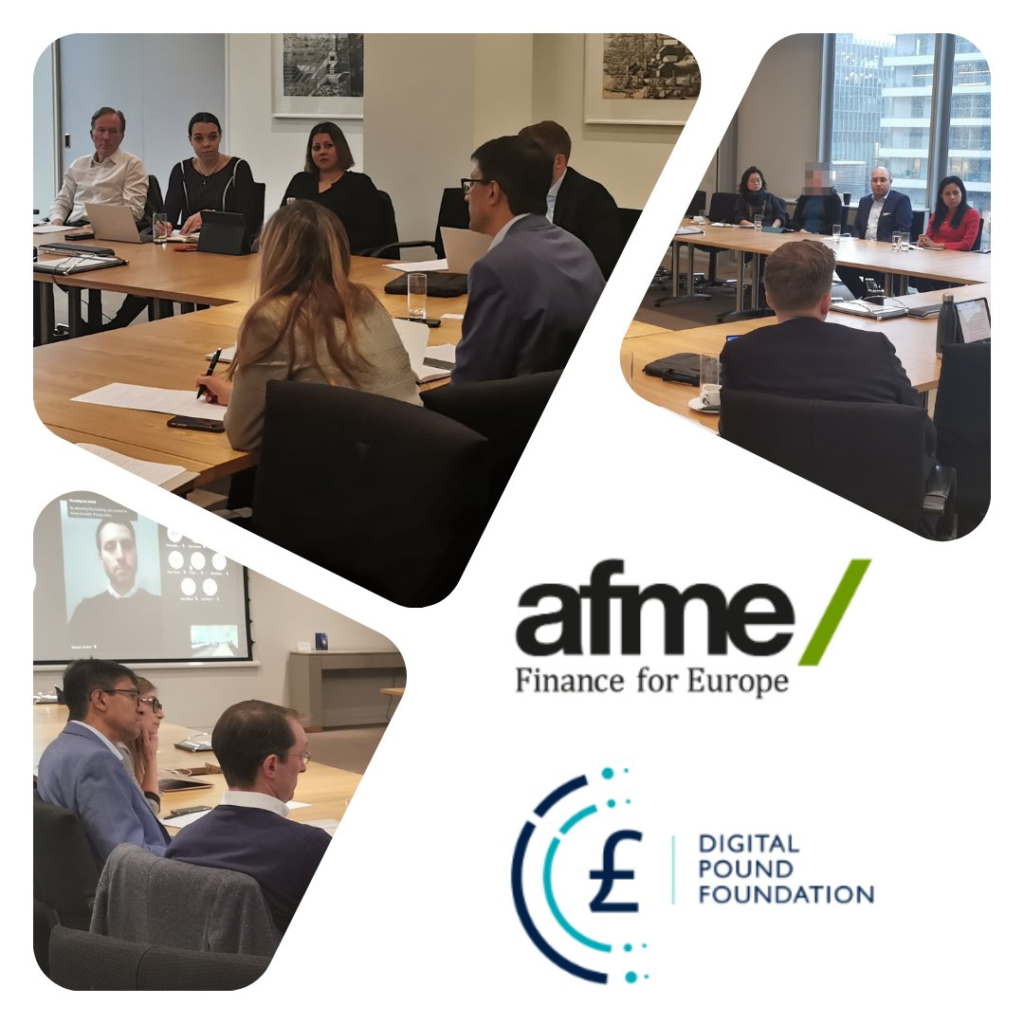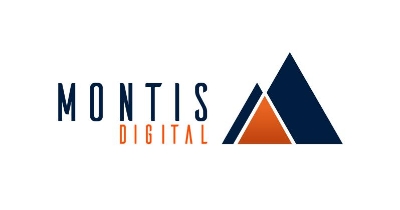Wholesale CBDC and digital assets settlement panel at the AFME (Association for Financial Markets in Europe)/Digital Pound Foundation event in London
Martin Watkins was discussing the use cases for wholesale CBDC and digital assets settlement at the AFME (Association for Financial Markets in Europe)/Digital Pound Foundation panel alongside representatives from Citi, JP Morgan, TP ICAP, UBS, Barclays, SDX, Accenture, Zodia Markets and Clifford Chance.
May 19, 2023
In March 2023, the Digital Pound Foundation (DPF) and Association for Financial Markets in Europe (AFME) hosted our first joint roundtable, with representatives from both organisations alongside industry specialists and external observers.
“As we cross the threshold from proof of concept to real traction, this joint event marks the beginning of a broader engagement in the wholesale financial markets space which we hope to build upon in the coming months and years. ” – Jannah Patchay, DPF Executive Director and Policy Lead.
“AFME looks forward to continuing to engage with both our members as well as the broader industry to consider the key viable use cases for wholesale Central Bank Digital Currencies (CBDCs), and the potential impact to capital markets and financial services more broadly.” – Elise Soucie, Associate Director, Association for Financial Markets in Europe (AFME)
The roundtable discussion focused on applications and use cases for wholesale CBDCs in financial markets and, from a broad and holistic perspective, the problems CBDCs are seeking to resolve. At a high level, these include:
- New settlement infrastructure for digital forms of traditional money, using blockchain deposits or deposit tokens
- A new mechanism for wholesale cross-border payments
- Seamless connectivity/interoperability with RTGS systems
- Lower cost access and participation
- Improved payments/value transfer security per fraud and cyber risks.
Participants agreed on the need for absolute legal certainty in the creation of digital assets and the resolution of fundamental legal questions underpinned currently by old legislation (which was not designed with digital asset – or digital asset owner – validation in mind). As such, it is critical to define and agree on operating and regulatory policy, and to understand exactly what types of agreements are needed in and between jurisdictions to support digital, low-cost, near-instantaneous payment value transfer.
“We must be emphatically clear which hoops must be jumped through for certainty of digital cash transfer and settlement in order to be confident that a decentralised infrastructure is sufficiently robust and risk-resilient.”
Harmonisation of regulation and cross-border operating standards is an imperative and an enormous challenge. Existing wholesale payments infrastructures are very effective and resilient, but not 100% efficient, due in part to the challenge of having different banks regulated differently in different places (and subject to different tax and reporting regimes). Digital assets and stablecoins are also subject to different regulations in different countries.
“There needs to be a willingness to support smaller use cases; ‘systemic’ cannot be the only CBDC use case on the table”.
With respect to cross-border payments, participants referenced a recently-completed CBDC project with central and commercial banks that looked specifically at resolving the frictions associated with traditional cross-border payments. Running over six weeks in autumn 2023, the project encompassed USD12m cash liquidity, 164 cross-border payments and associated FX PvP transactions totalling USD22.1m, and demonstrated the opportunity for central/commercial bank collaboration.
There was broad roundtable agreement that the technology discussion is, to some extent, moot without first having a full understanding and definition of the high-level policy (and regulations) governing how CBDCs are created and used. Similarly, it is important to have rigorous cost-benefit analysis of who will be paying for what with respect to the cost to the public sector and industry participants. Viability analysis also needs to consider other factors including access, distribution, core functions, compensation models, resilience, interoperability, liquidity, collateral fragmentation, etc, from both an operational and cost perspective.
“Currently, USD and USDC are not interoperable or interchangeable – you can’t switch automatically between them”.
Asset fungibility, and auto conversion of CBDCs, digital coins and traditional assets within a value transfer mechanism is crucial: not only will different countries and regions have their own CBDCs, but potentially, these will sit alongside bank-issued stablecoins (e.g. UBS or JP Morgan coin) and conventional fiat currency. Achieving T+0 settlement in this context will require significant changes to existing regimes, KYC/AML requirements, asset metadata collection and management and so on.
In addition to the potential for increasing liquidity (freeing up working capital/cash trapped in global payments cycles) CBDCs and associated digital payment systems could reduce settlement risk by operating on a 24/7 basis i.e. not being restricted to Central Banks “opening hours”.
“How do we transition wholesale CBCDs from single to multiple jurisdictions, how do we complement what is already there and how do we align central bank initiatives with those evolving on the commercial bank side?”
Understanding the impact on/interoperability of CBDCs and associated digital payments infrastructure and processes with existing payments infrastructure in the context of T+0 settlement is another key factor. To this end, a number of public/private partnerships and CBDC initiatives are already looking at how to leverage the full value of central/commercial bank collaboration. Some proposals are also considering how to widen the intermediary base and access (via intermediaries) to non-bank entities to facilitate and broaden distribution, and whether and how that will impact traditional players with respect to potential ‘disintermediation’. (At the same time, introducing other participants creates its own challenges with respect to minimum compliance standards and obligations, and ensuring a level playing field).
“It’s really important to think about those who do not currently have access to CBDCs, and the use cases for these segments.”
Infrastructure/system ownership is key, particularly in the case of bank consortia rather than Central Bank-owned structures. Will industry be more comfortable with one centralised ‘actor’ running the blockchain or DLT with associated and decentralised groups of permissioned actors? There is a huge network of independent actors building open source public blockchain infrastructure, building custody and trading solutions and issuing many and varied digital assets.
“Financial innovation is being driven by the private sector while wholesale CBDCs are about harmonisation and standardisation.”
Our industry experts agreed that there are potentially multiple flavours of public/private solutions, with respective pros and cons. A central bank approach (uni- or multi-lateral) could evolve quickly from a technological and regulatory perspective, particularly in the context of a complement to traditional RTGS infrastructure. But all stakeholders have to be considered – for example, how will commercial banks participate or access a central bank DLT network? An alternative structure may be one where the technology layer is owned by a bank consortium.
If central banks intend to use CBDCs to influence monetary policy (e.g. wholesale CBDC lending) there is potential conflict with respect to (private) commercial bank involvement where there are not the same limitations or public interest concerns. Another approach being pursued by the Singapore Monetary Authority is ‘purposeful money’ or a digital currency asset that can be used for particular monetary interventions. There are also potential sovereignty challenges, for example, bringing together all of the member states of the European Union (not all of whom are in the Eurozone) to adopt an additional means of transfer value.
“There needs to be a willingness to support smaller use cases; ‘systemic’ cannot be the only CBDC use case on the table”.
Industry adoption – geographic vagaries?
An interesting point made in the roundtable is that less ‘mature’ financial markets i.e. those outside of the UK/US/Europe and with less ‘developed’ payment infrastructures are more enthusiastic about the potential of digital cash and can adopt it more easily since they don’t have the same challenge of co-existence and interoperability with existing, embedded payments infrastructure. The analogy given was that of mobile phone adoption in many African and Asian countries, which leapfrogged the development of a landline infrastructure.
Trends in tokenisation
It is important to look at how tokenised and conventional assets can coexist and to understand how a wholesale CBDC and conventional payments can be brought together in terms of settlement. Industry is seeing massive interest in asset tokenisation, particularly around bond issuance. There is huge momentum in the US to build a digital exchange CSD capability, and activity in HKMA and Cyprus jurisdictions. Banks including AIB, Northern Trust and HSBC are also looking at this space, the latter having recently issued a white paper suggesting it could be a $16trillion dollar market and potential opportunity.
Bifurcation/market fragmentation
With the development of innovative digital instruments and distribution channels comes the risk of bifurcation and market fragmentation, which is not necessarily in the interest of financial markets nor welcomed by regulators. That said, another industry perspective – using the CCP example – is that there will always be some degree of product concentration with specific entities, regardless of choice, so bifurcation is an inevitable part of the digital asset journey. A financial instrument issued by a central bank but tokenised by another entity also raises privacy issues.
About the organisers
Digital Pound Foundation (DPF): Launched in 2021, the Digital Pound Foundation is a not-for-profit corporate membership organisation, advocating for the introduction of a well-designed digital Pound, in both public and private forms, and a diverse, effective and competitive ecosystem for new forms of digital money in the UK.
The Association for Financial Markets in Europe (AFME): represents a broad array of European and global participants in the wholesale financial markets. Its members comprise pan-EU and global banks as well as key regional banks, brokers, law firms, investors and other financial market participants. AFME advocates for stable, competitive, sustainable European financial markets that support economic growth and benefit society supporting the development of a robust digital assets economy from within an appropriate regulatory perimeter.



